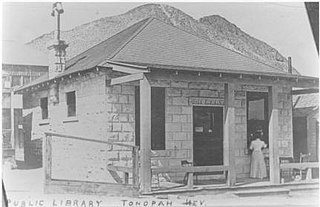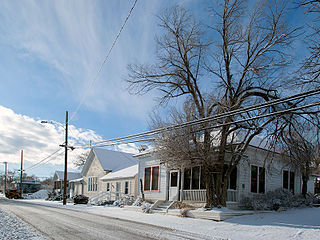
The Tonopah Public Library in Tonopah, Nevada was the third public library in Nevada.The one story stone building was designed by John J. Hill and was completed in 1906. The library was established by local residents Grace R. Moore and Marjorie Moore Brown to house a gift of 200 books from George F. Weeks.
John James Hill (1853–1932), known as John J. Hill, was born in Leicester, England. He was a stonemason and builder in Utah and Nevada in the United States.

The Tonopah Liquor Company Building is a historic building located on Main St. in Tonopah, Nevada. The building was constructed in 1906 by the Tonopah Liquor Company. The stone building was designed in the Classical Revival style and features a large pediment with a stone cornice. While the building was one of many stone structures built in Tonopah's early history, it is now one of only four remaining in the town; a local historic survey claimed it to be the most well-crafted of the remaining buildings.

The Water Company of Tonopah Building is a historic building located at the intersection of Burrough and Brougher Avenues in Tonopah, Nevada. Built in 1909, the building housed offices for the Water Company of Tonopah. Tonopah's first water service began in 1902, when three water companies each gained franchises to provide water to one district of the town. By 1905, Philadelphia businessman John Brock owned two of the water companies, which he consolidated into the Water Company of Tonopah. Brock also owned multiple mines in Tonopah and the local railroad. The Water Company of Tonopah Building is the only surviving building which belonged to one of Tonopah's early water companies.
The Tonopah Mining Company Cottage is a historic house located on Queen Street in Tonopah, Nevada. Built in 1902, the home is one of the oldest frame houses in Tonopah. The house was constructed by the Tonopah Mining Company, the largest silver mining company in Tonopah. The cottage was the second home built for the company's employees and the oldest of the three surviving company houses built by the company.
The Tonopah Mining Company House is a historic house located on Queen Street in Tonopah, Nevada. The house was built in 1904 by the Tonopah Mining Company and served as a company house for its employees. The wood-frame house was designed in the Georgian Revival style. The house's design features an entrance porch topped by a gable, three chimneys, boxed eaves, and molded cornices.
The Nye County Mercantile Company Building is a historic building located at 147 Main St. in Tonopah, Nevada. The two-story concrete block building was constructed in 1905. While concrete blocks were a popular building material in the era, the building was one of the first in Tonopah to be built with the blocks. Businessman Henry C. Cutting built the building to house his mercantile business. Cutting opened the first mercantile business in Tonopah; he reorganized the business as the Nye County Mercantile Company when he constructed its new building.

The Frame Cottage is a historic house located at 183 Prospect St. in Tonopah, Nevada. The wood-frame home was built c. 1909. The house features a gable roof with pediment-like gables, a porch with a pediment, classically influenced boxed eaves, and a symmetrical, T-shaped design. While frame houses were once common in Tonopah, the house is one of the few intact local examples of a frame home with a detailed design.
The Cal Shaw Adobe Duplex is an adobe house located at 129 Central Street in Tonopah, Nevada. The house, which was built in 1905, is typical of the adobe homes commonly built in Tonopah in the early 1900s. The building's exterior is scored to resemble stone; the home's design also features a decorative frieze and a porch supported by turned columns. The home has changed little since its construction and has been called "the best preserved adobe residence in Tonopah" by a local historic survey.
The Cal Shaw Stone Row House is a stone row house located on Central Street in Tonopah, Nevada, United States. Property owner Cal Shaw built the house in 1906 next to the Cal Shaw Adobe Duplex, which was built the previous year. While the house was built with stone instead of adobe, it features a similar design to the adobe house, particularly in its projecting roof and porch supported by columns. The house and its neighbor reflect the variety of homes built on Central Street, one of the earliest residential areas in Tonopah. In addition, the house's detailed and well-preserved design led a local historic survey to call it "one of the best preserved examples of stone residential construction in Tonopah".
The Combellack Adobe Row House is an adobe row house located on Central Street in Tonopah, Nevada. The Tonopah Extension Mining Company built the home in 1903 to house its employees. The house is the oldest adobe home in Tonopah; its walls were cast in place rather than built in blocks, as the former method was more efficient and more popular in the town. The home was part of one of Tonopah's first residential areas on Central Street, which was a well-developed district by 1904. J.M. Combellack, who had lived in the home since it was built, became its owner in 1905.
The Stone Jail Building and Row House are two adjacent stone buildings located on Water Street in Tonopah, Nevada. The jail was built in 1903 and the adjacent row house in 1908. Both building were at one time used as a brothel. The buildings were added to the National Register of Historic Places in 1982.
The Brann Boardinghouse is a historic boarding house located on Bryan Street in Tonopah, Nevada. The 2+1⁄2-story building is the largest wood-frame residence in Tonopah. The building's design includes a two-story porch with a balustrade along the second floor, molded cornices, boxed eaves, and a hipped roof; the inside has 18 rooms connected by two central hallways, one on each floor. Mrs. A.J. Brann built the boarding house in 1906. It was one of many boarding houses built in Tonopah to house the community's miners. The house is now one of only four boarding houses remaining in Tonopah.

The State Bank and Trust Company Building, more commonly known as the Belvada, is a historic bank building located at 102 Brougher Avenue in Tonopah, Nevada. The building was constructed in 1906 for the State Bank and Trust Company, a local bank founded in 1902. Architect George E. Holesworth designed the building in the Classical Revival style. Holesworth's design features granite pilasters separating the building's bays, a dentillated metil cornice with modillions along the roof, and an egg-and-dart cornice at the top of the first floor. The bank moved into the building in June 1907, but it only occupied it for four months. The bank had lent the L.M. Sullivan Trust Company, a land speculating company, a large sum, and when the company failed, the bank did as well. In 1908, the Nevada Club Saloon opened in the building; it was joined by the First National Bank of Nevada later in the year. The five-story building and the nearby Mizpah Hotel, also five stories, were the tallest buildings in the state until 1927.
The Zeb Kendall House, at 159 University Ave. in Tonopah, Nevada, United States, was built in 1906. It was listed on the National Register of Historic Places in 1982.

The John Gregovich House, at 101 Summit in Tonopah, Nevada, United States, is a historic house built in 1906 that is listed on the National Register of Historic Places. Like the Zeb Kendall House, also built in Tonopah in 1906 and also NRHP-listed, it is of Neo-Colonial style.
The Dr. J. R. Masterson House, at Ohio Ave. and 2nd St. in Tonopah, Nevada, is a 35-by-35-foot stone and frame historic building that was built in 1908. It has also been known as the Fred Chapman House. It was built as a residence and later served as a rooming house for most of its existence. It was a work of James Golden. It was listed on the National Register of Historic Places in 1982.

The E. R. Shields House, at 351 St. Patrick in Tonopah, Nevada, United States, was built in 1904. It includes Late Victorian details in a largely "Neo-Colonial" design. It was listed on the National Register of Historic Places in 1982.
The Irving McDonald House at 191 Booker in Tonopah, Nevada, United States, is a historic stone house that was built in 1906. It was listed on the National Register of Historic Places in 1982.
The E. E. Burdick House, at 248 Prospect St. in Tonopah, Nevada, United States, was built in 1906. It has also been known as St. Marks P.E. Church Parsonage. It was listed on the National Register of Historic Places in 1982.









